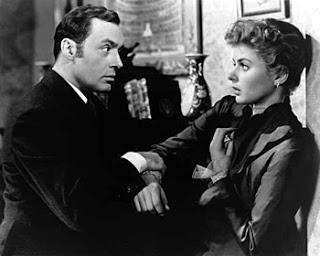"I knew from the first moment I saw you that you were dangerous to me."
Patrick Hamilton's Gas Light (also known as Angel Street) remains engrained in Western culture for describing a particularly heinous mental torture. It also inspired two films, of which George Cukor's lavish 1944 version is better-remembered.Paula Alquist (Ingrid Bergman) is the niece of an opera singer murdered for her jewelry. She marries Gregory Anton (Charles Boyer), a charming musician who isn't what he seems. Soon after their marriage he begins questioning Paula's sanity, blaming her for actions she has no memory committing, or hearing strange noises in the attic. Scotland Yard Inspector Brian Cameron (Joseph Cotten) grows convinced that Gregory has an ulterior motive.
The 1940 British Gaslight has its charms, notably a strong performance from Anton Walbrook, but the Hollywood version eclipses it. Cukor and photographer Joseph Ruttenberg drape the movie in impeccable atmosphere, with fog-shrouded streets, shadowy alleys and a creepy, crowded attic. Cukor gives his stars (especially Bergman) flattering close-ups, faces glowing even as they lurch towards madness, with his multinational cast providing a cosmopolitan flavor.
This grants Gaslight a surface romanticism, playing off its appealing stars. The key murder occurs off-screen and there's a long interlude before plunging into the main story. Cukor builds suspense by peeling away our initial impressions of Gregory: he plays the controlled, concerned husband to a fault, but poorly-timed outbursts tip his hand. Paula's rendered helpless as he engineers public humiliations and their servants feed into her insecurities.
If Gregory's game is easy enough to guess, Gaslight still works as a frightening portrait of abuse. An aggressive man forcing himself onto a woman who wants to please him, causing her to accept his attacks without thought. She's not balanced enough to wonder why this creep treats her the way he does, refusing to believe the worst. Cukor offers relief with the suave Brian (invented for the film; Hamilton's detective isn't so romantic) and gives Paula a meaty scene telling Gregory off. Even so, it's discomfiting fare.
Ingrid Bergman won her first Oscar for this role, and she's picture-perfect as a weary, confused woman unwilling to believe herself. Charles Boyer steals the show, playing drastic against-type as a Latin lover gone bad. His subtle wheedling and calculated rage make for a frighteningly credible villain. Joseph Cotten is less convincing with his Virginia accent intact and a thin character, Dame Mae Whitty's nosy neighbor is more appealing. Angela Lansbury makes her debut as a snotty servant.
The main knocks against Gaslight are its concessions to Hollywood convention: the actors are glamorous, Paula's tentative relationship with Brian seems unnecessary, and the story seems softer than its British predecessor. Still, the underlying story retains its power, and who can fault expert craftsmanship?


